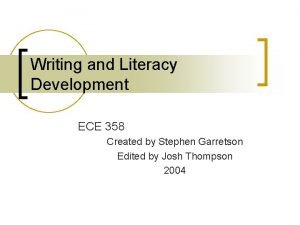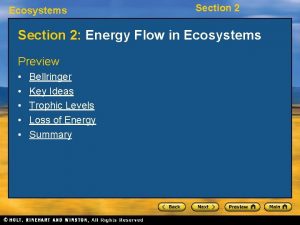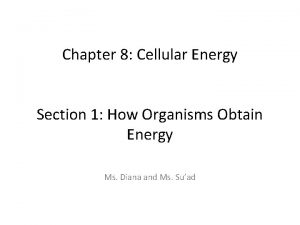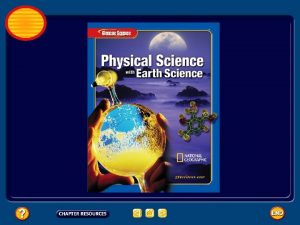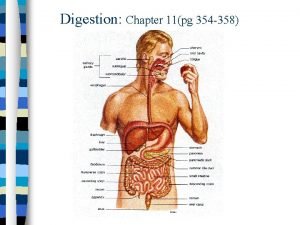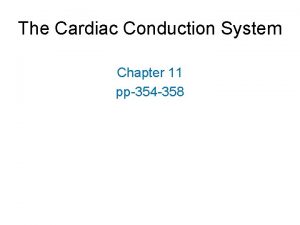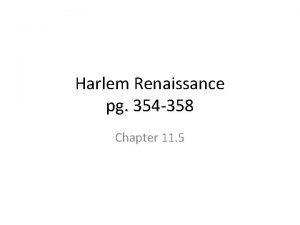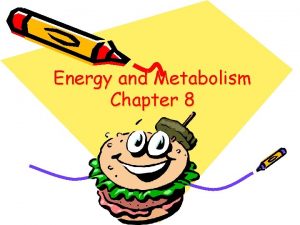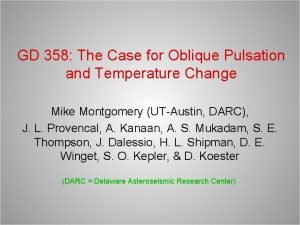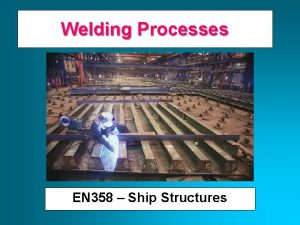Chapter 9 Section 4 pg 358 Energy Pg




















- Slides: 20

Chapter 9 Section 4 – pg 358 Energy

Pg 358 • Work: an object is caused to move a certain distance; the transfer of energy (measured in joules) • Energy: the ability to do work or cause change (measured in joules) A pitcher does work on a ball when pitching – energy is transferred to the ball from the pitch

Pg 359 Kinetic Energy • Kinetic Energy: the energy an object has due to its motion – kinetos Greek for “moving” • The kinetic energy of an object depends on both its mass and its speed – Kinetic energy increases when mass increases • This is why a bowling ball dropped on your toes hurts more than a tennis ball – Kinetic energy also increases when speed increases • A fast traveling bowling ball will knock down more pins than a slow one

Pg 359 • Kinetic Energy = ½ x Mass x Speed 2 • Note that changing the speed of the object will have a greater effect on its kinetic energy than changing its mass by the same factor

Pg 360 Potential Energy • Some objects have stored energy as a result of their positions or shapes • Potential Energy: stored energy that results from the position or shape of an object – This type of energy has the potential to do work

Pg 360 Gravitational Potential Energy • Gravitational Potential Energy: potential energy related to an object’s height • An object’s gravitational potential energy depends on its weight and on its height relative to a reference point • Gravitational Potential Energy = Weight x Height

Pg 360 Elastic Potential Energy • Elastic Potential Energy: the potential energy of objects that can be stretched or compressed

Pg 361 Energy Transformation and Conservation • Mechanical Energy: an object’s combined kinetic energy and potential energy • Mechanical Energy = Kinetic energy + Potential energy • A ball thrown into the air has both kinetic (from its motion) and potential (from its height) energy

Transformations Between Potential and Kinetic Energy • One of the most common energy transformations is the transformation between potential energy and kinetic energy • Any object that rises or falls experiences a change in its kinetic and gravitational potential energy • In a pendulum, a continuous transformation between kinetic and potential energy takes place Pg 362

Pg 363 Conservation of Energy • The law of conservation of energy states that when one form of energy is transformed to another, no energy is destroyed in the process – According to the law of conservation of energy, energy can not be created or destroyed • If you add up all the new forms of energy after a transformation, all of the original energy will be accounted for http: //www. pbs. org/opb/circus/classroom/circus -physics/conservation-energy/

Chapter 9 Section 4 Homework – pg 363

1 A. What is kinetic energy? In what unit is it measured?

1 B. What factors affect an object’s kinetic energy?

1 C. A 1, 500 -kg car is moving at a speed of 10 m/s. What is the car’s kinetic energy?

2 A. What is potential energy?

2 B. What factors affect an object’s gravitational potential energy?

2 C. What is the potential energy of a 500 -N pole-vaulter when she is 4 m above the ground?

3 A. State the law of conservation of energy in your own words

3 B. Describe the energy transformations that occur when you bounce a ball

3 C. Suppose a ball had a potential energy of 5 J when you dropped it. What would be its kinetic energy just as it hit the ground?
 Dal 358
Dal 358 Diffuser
Diffuser Ece 358
Ece 358 Saarekejärjestelmä
Saarekejärjestelmä Section 2 describing energy (continued)
Section 2 describing energy (continued) Chapter 5 thermal energy answer key
Chapter 5 thermal energy answer key Cellular energy section 1 how organisms obtain energy
Cellular energy section 1 how organisms obtain energy Energy energy transfer and general energy analysis
Energy energy transfer and general energy analysis Energy energy transfer and general energy analysis
Energy energy transfer and general energy analysis Section quick check chapter 10 section 1 meiosis answer key
Section quick check chapter 10 section 1 meiosis answer key Chapter 2 section 2 flow of energy in an ecosystem
Chapter 2 section 2 flow of energy in an ecosystem Chapter 4 section 1 the nature of energy worksheet answers
Chapter 4 section 1 the nature of energy worksheet answers Chapter 4 work and energy section 1 work and machines
Chapter 4 work and energy section 1 work and machines Chapter 8 section 1 how organisms obtain energy answer key
Chapter 8 section 1 how organisms obtain energy answer key Chapter 8 section 1 how organisms obtain energy
Chapter 8 section 1 how organisms obtain energy Chapter 8 section 1 how organisms obtain energy
Chapter 8 section 1 how organisms obtain energy Chapter 7 energy conservation of energy
Chapter 7 energy conservation of energy Under what conditions, a sectional view is preferred?
Under what conditions, a sectional view is preferred? Sectional views in engineering drawing
Sectional views in engineering drawing Sectional view examples
Sectional view examples Section 1 what is energy answer key
Section 1 what is energy answer key


